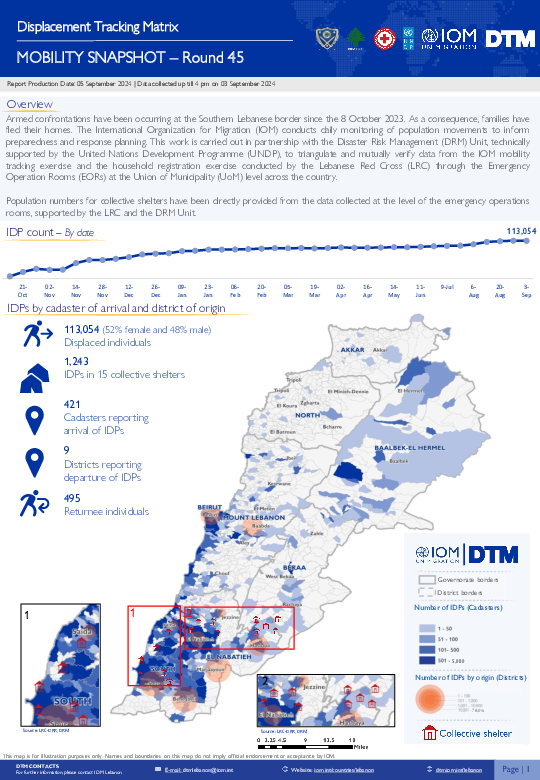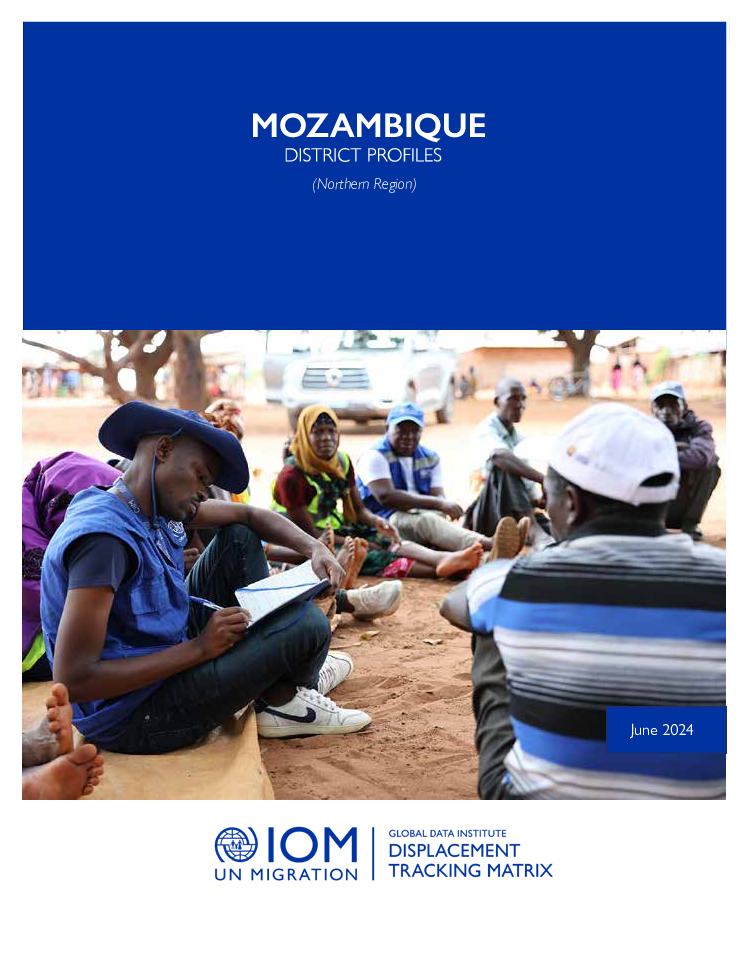-
Countries
-
Data and Analysis
-
Special Focus
-
Crisis Responses
Assessment Report

Contact
DTM Europe, DTMMediterranean@iom.int
Language
Romanian
Location
Republic of Moldova
Period Covered
Jan 01 2023
Dec 31 2023
Activity
- Survey
- Flow Monitoring
- Dintre respondenți, 41 la sută sunt activi (angajați sau șomeri), iar 53 la sută sunt inactivi (statut de student, concediu pentru creșterea copilului, pensionare, șomaj și nu își caută un loc de muncă).
- În cadrul populației active, 64 la sută sunt angajați și 36 la sută sunt șomeri.
- Înainte de deplasare, 81 la sută erau angajați și 19 la sută erau șomeri.
- Primele 4 sectoare de ocupare a forței de muncă includ: cazare (13%), comerț cu ridicata și cu amănuntul (11%), educație și știință (10%) și sănătatea umană și asistență socială (9%)
- Satisfacția privind potrivirea locului de muncă și a competențelor este mai mare în rândul bărbaților (74%) decât al femeilor (71%)

Contact
DTM Europe, DTMMediterranean@iom.int
Language
Romanian
Location
Republic of Moldova
Period Covered
Jan 01 2023
Dec 31 2023
Activity
- Survey
- Flow Monitoring
- 20 la sută dintre respondenți au sau locuiesc cu persoane cu nevoi specifice sau afecțiuni medicale grave
- Principalele probleme de sănătate pentru femei includ boli cronice sau afecțiuni medicale grave (12%), sarcina sau alăptarea (3%), dificultăți de mers (2%) și deficiențe de vedere (1%)
- Principalele probleme de sănătate pentru bărbați includ boli cronice sau afecțiuni medicale grave (22%), dificultăți de mers (5%), deficiențe de vedere (4%) și deficiențe de auz (2%)
- 61 la sută dintre cei cu o afecțiune de sănătate intenționează să rămână în Republica Moldova
- Primele 3 nevoi includ sprijin financiar (64%), medicamente (32%) și servicii de sănătate (31%)
- Majoritatea respondenților raportează că nu există bariere în calea serviciilor de asistență medicală (84%)
- Cei care raportează bariere citează costuri ridicate (9%), servicii indisponibile (2%), bariera lingvistică (1%) și timpii de așteptare (1%)

Contact
DTM Europe, DTMMediterranean@iom.int
Language
English
Location
Latvia
Period Covered
Mar 01 2024
May 31 2024
Activity
- Survey
- Flow Monitoring
From 12 March to 28 April, IOM's Displacement Tracking Matrix (DTM) in Latvia interviewed a total of 101 individuals as part of the New Arrivals survey. The results from these interviews are presented in the following pages. This survey provides findings on the needs and intentions of newly arrived refugees from Ukraine who have been in Latvia for three months or less.
KEY FINDINGS
- 101 Ukrainian respondents: 64% women, 36% men.
- Top oblasts of residence: Sumska (38%), Dnipropetrovska (28%), Kyivska (19%)
- Movement intentions: moving to another country (94% of both men and women), no intentions to move (4% of women and 3% of men), moving to the place of origin (2% of women), moving within current country (3% of men).
- Countries of final destination: Poland (77%), Norway (9%), Finland (8%), Austria (2%), Albania (1%), Czechia (1%), Netherlands (1%).
- Priority needs in the destination country: financial support (88%), long-term accommodation (42%), food supply (37%), health services (19%), general information (13%).

Contact
DTM Europe, DTMMediterranean@iom.int
Language
English
Location
Republic of Moldova
Period Covered
Apr 01 2024
Jun 30 2024
Activity
- Survey
- Return Intention
IOM’s Displacement Tracking Matrix (DTM) collects data on Ukrainian nationals and Third-Country Nationals (TCNs) that were crossing back to Ukraine from or through the Republic of Moldova, either for temporary stay or prospective return. The survey focuses on the return intentions, duration of displacement, destinations, assistance, and experiences of unequal treatment of the respondents. A total of 1,783 surveys were collected between April and June 2024.
Key findings:
- 70% of Ukrainian respondents planned to go for a short visit, 18% intended to stay in Ukraine (prospective returnees), while 12% were not sure about their intentions.
- Half of the respondents (49%) had been residing in the Republic of Moldova, 9% in Romania, 6% in Germany. The remaining 36% stayed in other countries.
- 86% were going back to their Oblast of origin, while 14% were going back to a different Oblast.
- 52% had been displaced between January and June 2022.
- 26% crossed back to Ukraine regularly since 2022, most of them (99%) had been residing in the Republic of Moldova.
- Main priority needs that were cited by respondents include financial support (37%), personal safety and security (31%) and long term accommodation (12%).

Contact
dtmlebanon@iom.int
Language
English
Location
Lebanon
Period Covered
Oct 10 2023
Sep 03 2024
Activity
- Mobility Tracking
- Baseline Assessment
Since October 8 there has been an increase in cross-border incidents between Israel and Lebanon, resulting in the displacement of people both within the South and elsewhere within the country. Since October 10, the Displacement Tracking Matrix (DTM) has been conducting the daily monitoring of population movements. The objective of the exercise is to inform preparedness and response planning.

Contact
DTM Mozambique, DTMMozambique@iom.int
Language
English
Location
Mozambique
Period Covered
May 15 2024
Jun 15 2024
Activity
- Mobility Tracking
The International Organization for Migration (IOM), in collaboration with the National Institute for Disaster Risk Reduction and Management (INGD), is pleased to share the Round 21 report of the Displacement Tracking Matrix (DTM) in northern Mozambique. This report covers data collected during assessments conducted in Cabo Delgado, Nampula, and Niassa by INGD and IOM between May and June 2024. It provides a comprehensive analysis of the demographic and mobility profiles of 577,545 internally displaced persons (IDPs) and 610,732 returnees displaced between 2017 and 2024 in Mozambique.
The report offers updated insights into the profiles of IDPs, and returnees affected by disaster and conflict, drawing on rigorous data collection, verification, and analysis across three(3) provinces. It highlights trends in displacement and return movements, emphasizing the ongoing need for data-driven, area-specific, and solution-oriented approaches to humanitarian, development, and peacebuilding interventions in crisis-affected communities.

Contact
DTM Mozambique, DTMMozambique@iom.int
Language
English
Location
Mozambique
Period Covered
May 15 2024
Jun 15 2024
Activity
- Mobility Tracking
The International Organization for Migration (IOM), in collaboration with the National Institute for Disaster Risk Reduction and Management (INGD), is pleased to share the Round 21 report of the Displacement Tracking Matrix (DTM) in northern Mozambique. This report covers data collected during assessments conducted in Cabo Delgado, Nampula, and Niassa by INGD and IOM between May and June 2024. It provides a comprehensive analysis of the demographic and mobility profiles of 577,545 internally displaced persons (IDPs) and 610,732 returnees displaced between 2017 and 2024 in Mozambique.
The report offers updated insights into the profiles of IDPs, and returnees affected by disaster and conflict, drawing on rigorous data collection, verification, and analysis across three(3) provinces. It highlights trends in displacement and return movements, emphasizing the ongoing need for data-driven, area-specific, and solution-oriented approaches to humanitarian, development, and peacebuilding interventions in crisis-affected communities.

Contact
DTMUkraine@iom.int
Language
English
Location
Ukraine
Period Covered
Jul 13 2024
Aug 12 2024
Activity
- Survey
The Oblast Profiles draw from data collected during Round 17 of IOM Ukraine’s General Population Survey (GPS), with an emphasis on demographics & displacement, the adoption of coping strategies to meet needs, employment & income, the IDP living allowance, and housing. These granular insights, categorized by population group at the oblast level, aim to inform strategic, programmatic, and operational decision-making.

Contact
DTMUkraine@iom.int
Language
English
Location
Ukraine
Period Covered
Jul 13 2024
Aug 12 2024
Activity
- Survey
Between 13 July and 12 August 2024, the International Organization for Migration (IOM) conducted Round 17 of the General Population Survey (GPS), a highly representative assessment of internal displacement in Ukraine. The data presented in this report was commissioned by the International Organization for Migration (IOM) and collected by 51 enumerators employed by Multicultural Insights through screener phone-based interviews with 40,000 randomly selected respondents and follow-up interviews with 1,488 IDPs, 1,188 returnees, and 1,800 residents, using the computer-assisted telephone interview (CATI) method, and a random digit dial (RDD) approach.
This report provides the main findings from Round 17 of the GPS, including detailed insights into population figures, displacement flows and mobility intentions, demographic profiles, household composition and vulnerabilities, and needs of the displaced population, to facilitate evidence-based decision-making on strategic, technical, and programmatic aspects of the response and recovery efforts in Ukraine.

Contact
DTMUkraine@iom.int
Language
English
Location
Ukraine
Period Covered
Jul 13 2024
Aug 12 2024
Activity
- Survey
Between 13 July and 12 August 2024, the International Organization for Migration (IOM) conducted Round 17 of the General Population Survey (GPS), a highly representative assessment of internal displacement in Ukraine. The data presented in this report was commissioned by the International Organization for Migration (IOM) and collected by 51 enumerators employed by Multicultural Insights through screener phone-based interviews with 40,000 randomly selected respondents and follow-up interviews with 1,488 IDPs, 1,188 returnees, and 1,800 residents, using the computer-assisted telephone interview (CATI) method, and a random digit dial (RDD) approach.
This report provides the main findings from Round 17 of the GPS, including detailed insights into population figures, displacement flows and mobility intentions, demographic profiles, household composition and vulnerabilities, and needs of the displaced population, to facilitate evidence-based decision-making on strategic, technical, and programmatic aspects of the response and recovery efforts in Ukraine.
Pagination
- Previous page
- Page 11
- Next page
